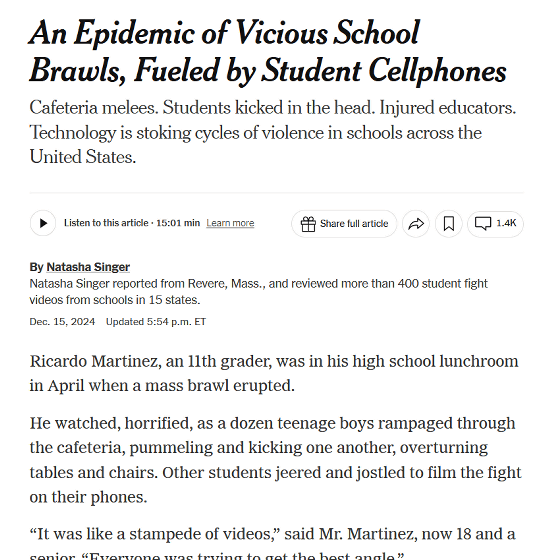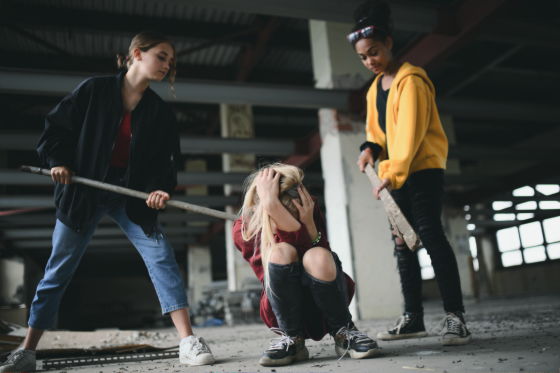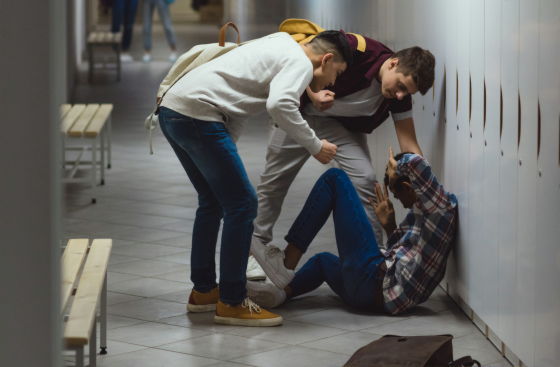In American schools where school violence is rampant, 'filming violent videos with smartphones and spreading them on social media' is fueling further violence.

In recent years, the rise in violence in schools has become a problem in the United States. According to a survey released by
How Student Phones and Social Media Are Fueling Fights in Schools - The New York Times
https://www.nytimes.com/2024/12/15/technology/school-fight-videos-student-phones.html

Opinion: Youth violence is on the rise. Is social media to blame? - The Globe and Mail
https://www.theglobeandmail.com/opinion/article-kids-are-growing-more-violent-is-social-media-to-blame/
One day in April 2024, a brawl broke out between a dozen teenagers in the cafeteria at Revere High School in Revere , Massachusetts. According to Ricardo Martinez, a former student who was present at the scene, many students were filming the students' violent actions with their smartphones, including punching each other and overturning tables and chairs. 'It was like a video frenzy,' Martinez told The New York Times. 'Everyone was trying to get the best angle.'
The commotion did not end there. Within minutes of the incident, word of the brawl spread via social media and chat to students outside the cafeteria, and dozens more students rushed to the cafeteria to watch the fight. Teachers blocked the entrance to the cafeteria to prevent students from gathering there, ordered students to wait in their classrooms, and administrators were forced to call the police. As a result, the high school suspended 17 students involved in the brawl.
The New York Times states, 'Across America, smartphone-driven technology—including text messaging, video, and social media—is fueling and sometimes intensifying school fights, disrupting school and disrupting learning. Videos of school fights often ignite a new cycle of cyberbullying, verbal attacks, and violence among students.' It explains that smartphone videography is fueling violence.
In fact, the New York Times investigated more than 400 violent videos filmed in schools in dozens of states, including California and Texas, and interviewed more than 30 teachers, police officers, students, and parents. The results revealed a pattern of middle and high school students using smartphones and social media to film and distribute brutally violent videos, and in some cases, the victims of the violence were reportedly killed.

The Canadian daily newspaper, The Globe and Mail, reported that violent incidents have increased by 114% in the past five years in Ontario, Canada, and that teachers' unions across the country are reporting unprecedented levels of student violence. The paper points out that the underlying problem is that isolation measures during the COVID-19 pandemic have led to children becoming engrossed in social media, creating an environment in which 'violent content' can become popular.
Since the COVID-19 outbreak, students have been using social networks to plan and incite violence, with violent videos of students being punched and kicked, or multiple students fighting, being spread across social media. Accounts have also appeared on Instagram and TikTok that collect videos of school violence filmed at schools in specific areas and post them with the initials of the high school's name, attracting significant attention.
In May, a group of girls at a junior high school in
In November 2023, a fight broke out at a high school in Wake County, North Carolina. Students filmed the incident, preventing administrators from intervening, resulting in a 15-year-old boy being stabbed to death . Chris Heagerty, chair of the Wake County Public Schools Board of Education, said, 'Many students were filming with their phones and posting to social media. They were putting themselves and others at risk in their efforts to get the best possible video.'

To adults, it may seem strange for ordinary students to film and distribute violent videos, but for the students themselves, violent videos are becoming a part of everyday life. Luna Guerrero, 16, a student at Revere High School, commented, 'Kids are so used to violent videos. They don't think it's something adults should be surprised by.' Endurance Nke, 17, also a student at Revere High School, expressed concern that the videos could desensitize students to violence, saying, 'Fights quickly become entertainment. There's no guilt or sympathy involved.'
Another problem has emerged in response to videos of violence being shared online, with unrelated people making derogatory remarks about the students, calling them 'animals,' and attempting to blame the violence on immigrants. Elta Ismahiri, an 18-year-old student at Libya High School whose parents are immigrants, said, 'Instead of caring about our safety, our mental health, and our feelings, we saw adults calling us 'animals.''
Revere High School hired additional school police officers in September, and teachers have begun enforcing a smartphone ban in classrooms. Thanks to these efforts, school violence has calmed down as of the time of writing.
TikTok, which has been accused of spreading violent videos, told The New York Times that it actively removes content depicting violent acts and accounts posting such content. Instagram also said it does not allow bullying on its platform, and removed content depicting physical violence and 16 accounts flagged by The New York Times for posting videos of school violence.
As the Chinese government faces an intensifying technological race with the United States, it is urging the country to incorporate artificial intelligence into its educational curriculum for six-year-olds.
Beijing urges Chinese schools to prioritize teaching AI amid US tech trade war | Semafor
https://www.semafor.com/article/12/15/2024/beijing-tells-chinese-schools-to-make-teach-ai-a-priority-amid-tech-trade-war
Related Posts:
in Education, Web Service, Posted by log1h_ik







